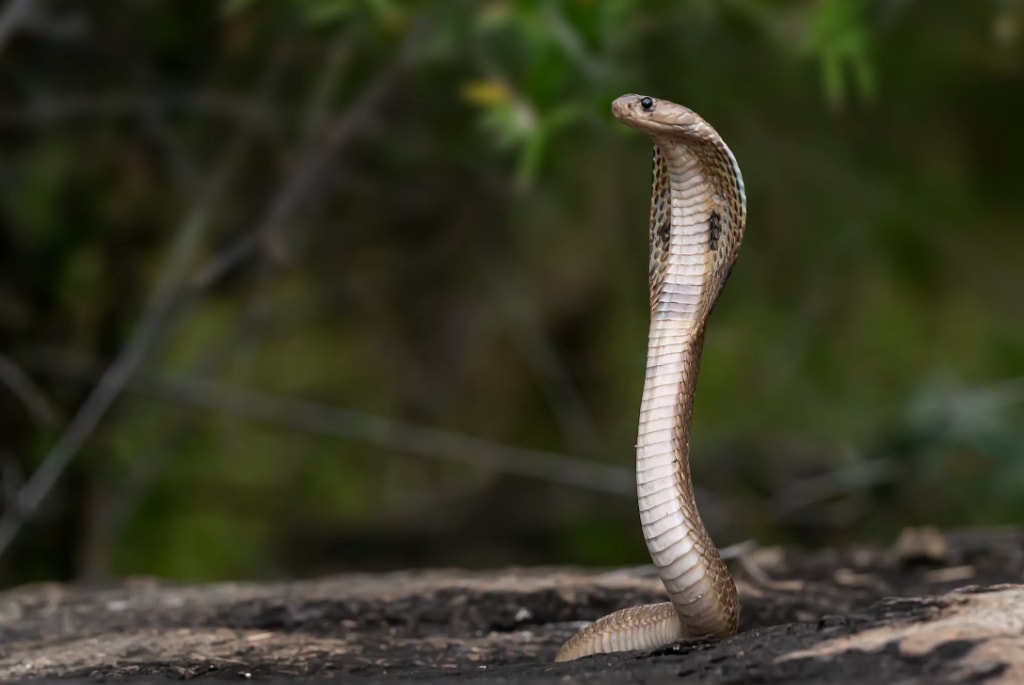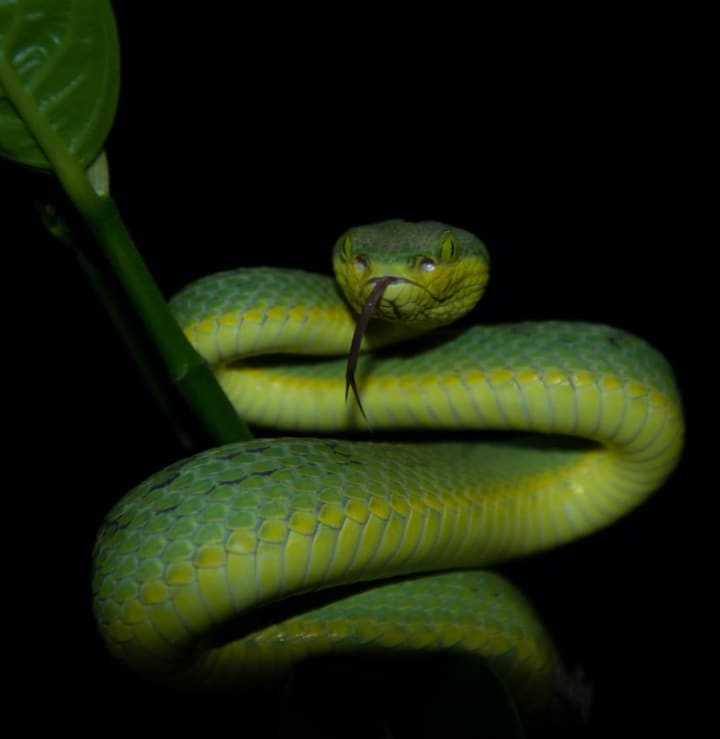How can a legless snake become an apex predator?
The evolution of snakes is unique

It is the changes in the snakes' bodies that are truly extraordinary. They have cut back on internal organs, almost removing a lung and leaving only a single lobe of the liver ...... They have evolved novel heat-sensing organs and a venom system that is the most complex of any animal. They can accelerate or reduce the metabolic rate to a greater extent than any other vertebrate. The in vivo modifications in snakes even go to the molecular level: some proteins that are stalwart in many vertebrates are quietly transformed in snakes.
How do legless snakes become apex predators?
Stephen Mackessy, a snake researcher at the University of Northern Colorado, says, "Evolutionarily, the snake is like a creature that has been re-engineered." In recent years, the genomes of two snake species have been sequenced for the first time, and with this, we are beginning to unravel the remarkable evolutionary journey of snakes.
The story of snake evolution began more than 100 million years ago with a lizard or a lizard-like reptile. Biologists are still debating which category the snake's ancestors belonged to. Some believe that snakes evolved from a marine reptile called a Cryptosaurus. But that's the minority. Harry Greene, an evolutionary biologist at Cornell University, says, "I think most of the evidence points to a terrestrial origin for snakes, and their ancestor was even an animal that was good at digging holes or was secretive in its movements."
The prevailing view is that the ancestors of snakes were the same group of reptiles as the extant giant lizards and large venomous lizards. So why did some members of this group lose limbs and elongate their bodies? Most likely to hunt insects in underground caves or tangled grasses. Indeed, the most primitive snakes found today still live underground, feeding on ants and termites, and are named blind snakes because of the degeneration of their eyes. The existence of the blind snake supports the idea that the ancestors of snakes may have lived in caves.
Snakes evolved to have elongated bodies without much genetic mutation. Michael Richardson, a developmental biologist at Leiden University in the Netherlands, says the "legs here" gene is still active in snake embryos, but its signal is ignored by cells at the long limbs, so legs can't form. During embryonic snake development, the spine grows extremely fast, resulting in a long, slender body. They have many more vertebrae than other animals, up to 500 or more in some species.
As appears to be the case in many cases, lizards seem to have had little trouble evolving snake-like bodies. Michael Lee, an evolutionary biologist at the South Australian Museum, says, "There are dozens of lizard lineages that have lost limbs." But most of them are so small and good at digging holes that they are generally hard to see and have hardly ever been studied.
Snakes always swallow their food whole, and can even swallow prey many times larger than themselves.
Extraordinary abilities
The ancestors of snakes went in the opposite direction, wiggling their bodies up to the ground and began hunting larger prey, eventually even emerging as intimidating predators like rattlesnakes and cobras. Today there are approximately 3,400 species of snakes that range throughout the world, except the cold polar regions. Some snakes live in tropical oceans, where they never come ashore. Other snakes, such as pythons, can grow to be very large. But the largest individual of any living snake is just a little guy compared to the titan python. The Titan Python is an extinct giant snake that could grow to more than 10 meters long and weigh more than a ton. The snake's diversity and range are unmatched by any other footless lizard. Lee says, "They are all far less successful than snakes."
So, what makes snakes so different? It's the less conspicuous changes that occurred when snakes lost limbs in their ancestors. In particular, snakes have a remarkable metabolic capacity. This ability emerged early in evolution: blind snakes, a more primitive group of snakes, were isolated early in snake evolution, and many changes were made to their mitochondrial genes. It is possible that these changes enabled primitive snakes to reduce their metabolic rate and reduce their energy expenditure.
Thus, this created the conditions that allowed early snakes to return to the ground and adopt a proven strategy - using sporadic binge eating instead of eating smaller meals. This way they do not have to spend all the time hunting, but also reduce the risk of the mantis in the back of the bird. Moreover, they can also use this to pass the period of food scarcity.
However, for an animal that has to swallow its prey whole, eating a large meal can be a challenge. The snake's remarkable ability to swallow prey larger than its head requires many changes to achieve. David Cundall of Lehigh University, for example, notes that the skin around a snake's mouth is normally folded up, so it expands more than most animals. Moreover, his research has shown that some muscles on the jaws of snakes can stretch so long that the linked actin and myosin are ripped apart and gradually return to their original position after feeding.
The ability of snakes to regulate their metabolism is even more uncanny. For example, between meals, Burmese pythons bring their metabolism to an almost complete halt, with metabolic rates dropping to the lowest levels of any known vertebrate. "Snakes have a very, very slow metabolism when they have nothing to do." Todd Castoe of the University of Texas at Arlington says, "The difference in metabolism between a living snake and a dead snake is minimal." So large snakes can go months without a single meal.
Metabolic miracle
Yet when a python swallows let's say an antelope, everything is different. The minute-by-minute digestion begins. Over several days of feeding, the python's small intestine and liver double in mass, and its kidneys and heart increase dramatically in size. At the same time, its metabolic rate increased to 45 times its original rate. The acceleration was almost as great as that of a horse sprinting at a Kentucky horse race, Castor said. "But that's running on a flat field, and when pythons reach their metabolic peak, they're stationary."
This stormy change lasts only a few days. Within about two weeks, the meal is digested and the snake turns its metabolism off again.
What makes snakes so skilled at regulating their metabolism is that in 2013, scientists completed sequencing the genomes of two snakes, the Burmese python, and the king cobra, for the first time, and Casto was part of the team at the time. By comparing their genomes with those of other vertebrates, they identified the genes that had changed, determined when the mutations arose and looked for traces of natural selection.
They were surprised to find that of the 7,442 genes shared by terrestrial vertebrates, 772 had changed due to natural selection. And most of these - 516 genes - were present in both snakes. That is, they appeared earlier than 80 million years ago, before the separation of the python and the lineage that later formed the cobra.
A few hundred genes may not seem like a lot of variation, but most of these genes are related to some basic function and diverge very little between species, so this is already a very unusual number. "This order of magnitude is much higher than what we're used to seeing," Castor said. He believes these broad-coverage genetic variations are responsible for the snakes' ability to regulate their metabolism and organ size as needed. His hypothesis has yet to be proven, but most of these genes are indeed linked to metabolism and organ development.
Castor found that snakes even modify one of the evolutionary "untouchables": a protein called cytochrome oxidase I, which helps cells "burn food" for energy. Casto explains, "That's why you need to inhale oxygen." While some of the structure of cytochrome oxidase has remained the same in almost all organisms for a billion years, snakes have made modifications to these key parts. Castor has not yet proven whether such changes are related to the snakes' powerful ability to control their metabolism, though he thinks it's likely that they are.
Of course, it's one thing to be able to speed up your metabolism to digest a big meal, it's another thing to have the ability to catch your prey. A branch of the snake family has evolved a very effective method of capturing large prey: with venom.
It is not clear exactly when venom evolved. Based on similarities in venom proteins, Bryan Fry of the University of Queensland in Australia has proposed that a common ancestor of snakes and extant venomous lizards evolved the ability to make venom about 200 million years ago. If so, then early snakes may have had toxic saliva, when snakes still had ordinary teeth, and when they bit other animals, the toxic saliva entered the victim's bloodstream through the wound. However, other biologists believe that the similarities Frey found are the result of convergent evolution rather than due to having a common ancestor. They argue that the venom of snakes and venomous lizards evolved separately under different circumstances.
Deadly venom is a powerful weapon for hunting.
Most venomous snakes have elaborate fangs, and the non-venomous python was separated from the ancestors of cobras, vipers, and other venomous snakes about 80 million years ago. What is certain now is that the fangs must have evolved at some point after that time. This ancestor evolved post-venom teeth with grooves in the teeth in which venom could flow. In some snakes, the fangs have moved to the front of the mouth, the grooves deepened, and eventually became syringe-like hollow-tube teeth, along with a muscular system for injecting venom into the canals.
Freek Vonk, an evolutionist at the Nature Biodiversity Center in Leiden, the Netherlands, and colleagues have been studying venom and fangs for a long time. They identified the venom gene in cobras and then searched for the nearest related gene in pythons and chameleons. To their surprise, the cobra seemed to have pieced together the venom from common "everyday objects. Most of the 20 gene families that encode venom are related to genes that do mundane "housekeeping" tasks within the cell.
These "everyday" genes are active at the lower levels of almost all tissues. Castor, who was also involved in the study, says, "This means that when a new gland is created, the chances of these genes being expressed in the gland are quite high." Sometimes, the snakes simply kidnap these genes and turn them into "poisonous" jobs. But more commonly, the original genes are copied, often several times, and the snakes have plenty of protein to experiment with and turn them into deadly toxins.
So most of the more evolved venomous snakes have a mixture of toxins in their venom. Some statistics yield a mix of more than 100 toxins. The composition of venom in venomous snakes varies with species, and location, and sometimes even different individuals of the same species have different compositions. Mixing toxins helps snakes stay ahead of the arms race: if snakes have only one toxin, it is easier for their prey (or predators) to evolve resistance.
Not all components of venom are designed to kill prey or fight off predators. Many species of snakes, especially rattlesnakes, have many toxins in their venom that work to break down the tissues of the bitten animal. Rattlesnakes' prey is usually large, which helps them finish digesting their food before it rots, Maxey said. In addition, Maxey recently discovered that rattlesnake venom contains a component known as depolymerization (crotatroxin), which prevents blood from clotting and also gives off an odor that helps rattlesnakes find the bodies of bitten animals after they die.
This is all just the beginning. Castor, Wanker, and their colleagues are already working on sequencing the genomes of more snakes. At the top of the list are a blind snake and the Malayan red-mouthed pit viper. The blind snake is of interest because of their close resemblance to earlier snakes, and the red-mouthed pit viper because of its infrared sensing abilities. Many adaptations have created a large group of strange and fascinating creatures, and completing the genome sequencing of these two snakes will further our understanding of snake origins and evolution. In Green's words, "Unlocking the secrets of snake biology holds unlimited promise."

Seeing with eyes closed
When the earliest snakes, while gaining certain extraordinary abilities, also lost others. After millions of years of living underground, the eyelids of primitive snakes, which were small and adept at digging holes, closed and their eyes degenerated. When early snakes returned to the surface, they had to piece together a usable pair of eyes from the parts still left. They had lost a special structure used to supply nutrients to the retina and evolved blood vessels to replace them, but these passed in front of the retina, obscuring the field of vision.
Add a caption (optional)
The snake's eyes once degenerated and then were put back together again.
The primitive snake also lost the ability to change the shape of the lens to adjust focus, and its descendants evolved an alternative method of focusing by moving the lens back and forth within the eye, much as Sherlock Holmes moved a magnifying glass to observe clues.
The closed eyelids remain tightly closed until now, but the eyelids have become almost completely transparent. Deprived of the protection of the normal eyelids, this transparent membrane is very easily scratched, although it is replaced with a new one each time the snake molts.
Another problem with this transparent membrane is that blood vessels are passing through it, and a 2013 study confirmed that these vessels constrict longer than normal when the snake sees something threatening, possibly to get a clear view at the moment of greatest need.
Although snakes do not have very good eyesight, they have very well-developed other senses. Some snakes even have infrared vision, and they have a special cheek fossa that senses heat.
One medicine for all poisons
If you are bitten by a venomous snake, a dose of anti-venom may save your life. Antivenom contains antibodies that neutralize the toxin. But which antivenom will work? Many snake bite victims do not know what snake has bitten them, so drug companies have produced a hybrid antivenom that works for several types of snake bites. But this serum is expensive and also increases the risk of causing allergies.
Nicholas Casewell of the Liverpool School of Tropical Medicine in England (Nicholas Casewell) and his colleagues believe that there is a better way. They used genetic methods to identify the same part of the venom protein of different species of snakes and then designed antibodies that bind to this same part, which means that each antibody can be effective against the bite of several species of snakes at the same time, and will eventually get safer and cheaper anti-venom.
About the Creator
Turnell Feliu
People who shiver from the cold can best appreciate the warmth of the sun. Those who have experienced life's troubles know best the preciousness of life






Comments
There are no comments for this story
Be the first to respond and start the conversation.